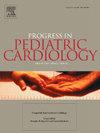Endothelial dysfunction in children with obesity-induced metabolic dysfunction-associated liver disease: Relationship to plasminogen activator inhibitor-1
IF 0.6
Q4 PEDIATRICS
引用次数: 0
Abstract
Background
Metabolic dysfunction-associated fatty liver disease (MAFLD), formerly known as non-alcoholic fatty liver disease (NAFLD), and cardiovascular abnormalities are closely related in adulthood, but few studies were performed in childhood to prove this relationship, and its pathophysiologic mechanisms have not fully studied yet.
Objectives
This study aims to assess vascular endothelial dysfunction in children with obesity- related MAFLD and to investigate its relationship to the plasminogen activator inhibitor-1 (PAI-1) levels.
Methods
In this case-control study, we assessed both brachial flow-mediated dilation (FMD) and carotid intima-media thickness (CA-IMT), in addition to liver profile, lipid profile, glucose, insulin, insulin resistance, fasting C-peptide, high-sensitivity C-reactive protein (hs-CRP), and PAI-1 in 200 children with obesity, 80 with and 120 without MAFLD, respectively.
Results
Compared with non-MAFLD, children with MAFLD had lower brachial FMD% (3.94 ± 1.42 versus 8.16 ± 2.32 p = 0.001), similar CA-IMT (0.45 ± 0.06 versus 0.45 ± 0.07, p = 0.09) and higher PAI-1 (55.16 ± 14.42 versus 43.32 ± 10.34 p = 0.000). Moreover, FMD% was significantly correlated with PAI-1 (r = −0.57, p = 0.001), hs-CRP (r = −0.474, p = 0.001), Homeostatic Model Assessment for Insulin Resistance (HOMA-IR) (r = −0.306, p = 0.01) and CA-IMT (r = −0.223, p <0.05). Using linear regression analysis, PAI-1 was the most significant independent predictor of FMD (p=0.001) in children with obesity-related MAFLD.
Conclusions
Children with obesity who have MAFLD showed impairment of FMD %, which was independently associated with elevated PAI-1 levels. Thus, the diagnosis of MAFLD in a child should raise urgent attention to its cardiovascular sequelae. In the management of MAFLD, the prevention of cardiovascular disease is crucial, along with the prevention of end-stage liver disease.
求助全文
约1分钟内获得全文
求助全文
来源期刊

PROGRESS IN PEDIATRIC CARDIOLOGY
PEDIATRICS-
CiteScore
0.90
自引率
11.10%
发文量
69
审稿时长
75 days
期刊介绍:
Progress in Pediatric Cardiology is an international journal of review presenting information and experienced opinion of importance in the understanding and management of cardiovascular diseases in children. Each issue is prepared by one or more Guest Editors and reviews a single subject, allowing for comprehensive presentations of complex, multifaceted or rapidly changing topics of clinical and investigative interest.
 求助内容:
求助内容: 应助结果提醒方式:
应助结果提醒方式:


